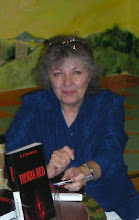Friday, October 16, 2009
New Mexico Magazine Review
Friday, September 11, 2009
Tierra Red Book Signing Date
Come join me at Atticus Books & Tea House from 2-5pm!
Big Thank You to Tome on the Range!
Monday, August 31, 2009
Tierra Red Book Signing Date
This is an especially exciting book signing since most of Tierra Red takes place in and around the Las Vegas community.
Thursday, June 25, 2009
Hastings Book Signing on June 20th
Friday, June 19, 2009
Tierra Red Book Signing News

Our first book signing was a lot of fun. COAS Books certainly knows how to make a body feel at home. In a few days, Hastings Books in Las Cruces will be hosting a similar event for Tierra Red.
We are in the process of establishing the schedule for this summer. Latest news is that we will definitely be at Tome on the Range Bookstore in Las Vegas, New Mexico on Labor Day weekend. As soon as the date has been established for Atticus Books & Tea House in Ruidoso, it will be published here, too.
Haven't meant to be so neglectful of posting historical points for Tierra Red. Look for a few new posts this weekend.
Wednesday, June 03, 2009
Tierra Red Book Signing Dates
Saturday, June 13th -- 10am at COAS Books, Downtown Mall, Las Cruces, NM
Saturday, June 20th -- 12noon at Hastings Books, 2350 Lohman, Las Cruces, NM
The cast of characters and I are looking forward to meeting all of you!
Saturday, April 11, 2009
Tierra Red Historical Point: White Sands Desert

The largest pure gypsum dune field in the world is located at White Sands National Monument in south-central New Mexico. The dunes cover an area of 275 square miles, 115 square miles of which are located within the White Sands National Monument. President Herbert Hoover proclaimed and established the monument in January, 1933.
Lily's harrowing escape from the catastrophic events that occur in Part One of Tierra Red culminates in her being stranded in these dunes. It is here that she discovers the treachery behind her arrival in the Territory of New Mexico.

I found a wonderful old legend concerning the White Sands Desert on the National Park Service website -- a ghost story!
The Legend of Pavla Blanca
To the Indians of central New Mexico, one of the most enduring legends is that of Pavla Blanca, the ghost of the Great White Sands. Hidden behind the swirling eddies of the spectral white dunes, her tragic story provides one of the most fascinating tales of the Southwest.
In early 1540, a valiant, young Spanish conquistador, Hernando de Luna, left his lovely betrothed, Manuela, in Mexico City to accompany the famed explorer, Francisco Coronado. Searching the uncharted lands in present day Arizona, New Mexico, Kansas, and Texas, Coronado followed every Indian clue, every tale, looking for the fabled Seven Cities of Cibola and Gran Quivira, where the houses were said to be studded with gold and the streets were afire with jewels.
Ambushed by the fierce, proud warrior Apaches on the edge of the Great White Sands, the Spanish battled for their life. Exhausted and beaten, the survivors fled southwest to Mexico City. It is said that Hernando de Luna was mortally wounded and perished somewhere in the ever-shifting white sands. Setting out to seek her betrothed somewhere north of what is now El Paso, Texas, the lovely Manuela was never seen again. It is said that the ghost of this beautiful Spanish maiden haunts the dunes of the Great White Sands. She comes nightly in her flowing, white wedding gown to seek her lover, lost and buried beneath the eternal dunes. Some say the ghostly figure usually appears as the evening breezes sweep and dip over the stark white dunes, just after sunset.
The moderns have it that Pavla Blanca is caused by a prevailing wind sweeping over the hushed and lonely desert in the evening, whipping wraith-like eddies of dust. But the Indians say it is the ghost of Manuela, still eternally seeking her lover.
Fact or fiction, those with imagination, strolling in the silent shimmering dunes after a fiery sunset may be fortunate enough to witness for themselves the unusual sight. Thus, this legend persists for some, even to this day. This is Pavla Blanca.
Wednesday, April 08, 2009
Tierra Red Historical Point: Stagecoach Travel
The inconveniences of our modern modes of travel are nothing compared to what passengers in the 1800's endured when traveling on bad roads in harsh weather which often made the stage coach run an exciting experience. The San Diego Union reported a typical incident in February, 1883:
"Frank Frary, who drove the Julian stage in last evening, says that when he started yesterday morning the wind was blowing a perfect hurricane from the east and northeast. The stage swayed so violently in the gale, that fearful that it would capsize, he and the two passengers piled two or three hundred pounds of rocks into the vehicle as ballast, which they carried until the grade had been passed."
Katie Leng offered insight to our modern world about stagecoach travel in a 1972 interview for the San Diego Historical Society. Leng, whose uncle ran Foster's Station, recalled the stages were:
" . . . miserable things to ride in. Let me say that the stage coaches galloping along in the Western movies always upset me, because it wasn't that way at all. The horses were trotted, with frequent breathers. Also, there was only one man on the box, and I never knew of any of them being armed. They wore any sort of clothing they wanted to, nothing flamboyant. We never had a hold-up. The only real tragedy I ever heard of was once, before my time, a driver was leading his team across a usually dry wash and was caught by a flash flood and drowned."
Sunday, April 05, 2009
Tierra Red Historical Point: Las Cruces
Tierra Red takes place during the years 1898-1900 in the Territory of New Mexico, featuring the Las Cruces, Las Vegas, and White Oaks areas.


Las Cruces has two historic districts: the Alameda-Depot District and the Mesquite District. Both districts are listed in the National Register of Historic Places.
The major streets of town were those running north-south, perhaps because the route of travel and commerce (Camino Real or Chihuahua Trail) ran in that direction. These streets were wider than the cross streets and were named Water (it fronted the irrigation ditch), Main (the business street), Church (location of the Catholic church and its plaza), Campo (for the camposanto or cemetary, Mesquite (for the desert shrub that covers the hills), and Tornillo (at the back of town, not named in the original platting.
Las Cruces was platted in 1849 on the hills south of several graves that served as a landmark for travelers, marking a crossroad and a place to cross the Rio Grande. The area became known as El Pueblo del Jardin de Las Cruces (City of the Garden of Crosses).
History tells us that a U. S. Army Lt. laid out the town in 1849 using nothing more than a rawhide rope with which he marked off the city's new streets. The heads of families took turns drawing a chance from a hat to determine which property they would own.
Lily's story begins in 1898 in this community, nearly fifty years later.
Monday, March 16, 2009
Book Club Discussion Guides
In the meantime, our heartfelt thanks to all those who have ordered the book so far and their lovely congratulatory wishes.
The next Historical Point will be posted in a few days . . . .
Monday, March 09, 2009
TIERRA RED is now published . . .
When you roll your mouse over Lily's face now, you will find that it links to an author's webpage with further links to Barnes & Noble, Amazon.com and an ebook format.
Each week I will begin posting character studies and more historical points from Tierra Red. There is such a wealth of historical information surrounding this story that we will run out of weeks before all of it can be told.
Stay tuned for some fun contests, too . . . .
Sunday, March 01, 2009
Tierra Red Historical Point: Land Grants
 (1895 U.S. Atlas - Territory of New Mexico Map)
(1895 U.S. Atlas - Territory of New Mexico Map)The mystery at the heart of Tierra Red involves stolen land grants. Remarkably, this issue is still a deep controversy in the state of New Mexico today. As recently as 1999, Senators Pete Domenici and Jeff Bingaman of New Mexico introduced legislation in the United States Senate to initiate renewed investigation and restitution for hundreds of ignored claims.
To gain a better understanding of how the issue of land grants affected the forming of the Territory of New Mexico, the following excerpt from the Historical Atlas of New Mexico by Warren A. Beck and Ynez D. Haase (1969) offers some insight.
The United States adopted the rectangular system of public land surveys in 1785. The system was based on the manner in which old town grants had been made in early Massachusetts. The new rectangular plan was intended to make settlers take all of the land instead of the choice parcels only, to provide an orderly method of recording land titles, and to describe titles in such a way that duplication would be avoided.
When the United States acquired the Southwest in the Mexican Cession of 1849, it inherited a very confused system of land tenure, which was at its worst in New Mexico. In the two and one-half centuries of Hispanic occupation, land was acquired most informally. In fact, the Hispanic manner of granting land title was anything but an exact science. Many landholders did not even possess the legal documents required to prove their ownership. Others had titles which described their holdings in such vague fashion it was impossible to define boundaries. It was common to use streams, hills, rock, or even trees to mark land division. Then, too, frequent transfers of titles or subdivisions were not properly recorded.
Under the peace treaty with Mexico in 1848 the United States government assumed the responsibility for certifying land titles which had existed previous to that date. In order to determine the extent and legality of these holdings, both public and private, which had been acquired under Spanish and Mexican rule, a control point had to be established which would permit land surveys that would be meaningful under the surveying system of the United States.
This control point was established in April, 1855, by John W. Garretson. He fixed the Initial Point on an isolated hill on the west bank of the Rio Grande not far from the Mexican village of La Joyita in Socorro County. From this point he ran the Principal Meridian of New Mexico south to the International Boundary and north 96 miles. The Base Line was run 21.5 miles west and 24 miles east of the Initial Point. A Guide Meridian and five Correction Lines were then run out. After this, an orderly program of cadastral or property boundary surveys were made.
Most of the early township surveys were made on grant lands in an effort to help establish proper title. Unfortunately, the court operated much more slowly than did the surveyors, and it took years in many cases to prove legal ownership.
Sunday, February 08, 2009
Tierra Red Historical Point: 1895 U. S. Atlas

Sunday, January 18, 2009

Dover Publications has graciously given the okay to use this gorgeous image in TIERRA RED.
I am so excited -- this piece of clip art sat next to my computer through all the years of writing and editing this novel.
She has become the only representation of Lily, the heroine, in my mind. I just wish Charles Dana Gibson was still alive so I could personally thank him!









